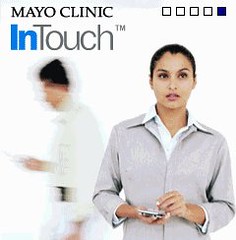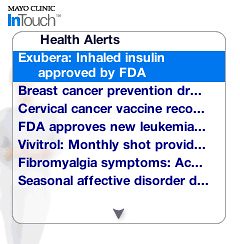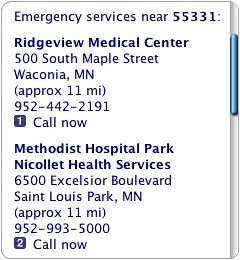This information is provided on an Embargoed basis for background consideration, and is not to be published until Thursday, Feb. 22. For more information or to schedule interviews, email Lee Aase at Mayo Clinic (aase.lee@mayo.edu) or call 507-266-2442.

Below is a video demo of an application called Mayo Clinic InTouch that is being launched this month, available on several of the largest US wireless carriers that serve more than 184 million users.
The application is developed and offered by Digital Cyclone, with content licensed from Mayo Clinic, MayoClinic.com and the Joint Commission on Accreditation of Healthcare Organizations. In addition to representatives from Mayo Clinic and Digital Cyclone, Sprint/Nextel has a spokesperson willing to be interviewed about adding the application to its services.
The video below is a three-minute demo of some of the application’s key benefits, which are available for $2.99 a month. And at the bottom of this post I share a true story from my family that illustrates how others will find it helpful for theirs.
The application has several sections:
- First Aid: What to do right away, and what NOT to do, to treat common illnesses and injuries.
- Emergency Room Finder: When you’re away from home and have a sudden need for medical care (other than life-threatening emergencies, for which you should always call 911), Mayo Clinic InTouch helps you locate nearby JCAHO-accredited ERs and Urgent Care facilities…either by entering the city or zip code or, in advanced phones, by automatically locating you and giving you the distance to nearby facilities.
- Symptom Checker: Guidance on when over-the-counter and home remedies are advised (and what those are), and when you need to seek professional medical help.
- Health Alerts: News you need to know.
- Health News Videos: Starting with Sprint, the application offers over 100 brief educational segments in 20 categories, from Alternative Medicine to Women’s Health. More carriers will add video over time, as will more timely analysis of breaking news and what it practically means for consumers.
[youtube=http://www.youtube.com/watch?v=1YkDSjclEws]
Here are some additional screen shots from the application:


And here is a story from this weekend, of how I used the application to advise my daughter and son-in-law, likely saving them hundreds of dollars. I share it with their permission.
My daughter Rachel called early (6 a.m.) Sunday morning and awakened my wife Lisa with a concern about her husband Kyle and his twin brother, Michael, who both had come down with severe stomach cramps and vomiting. They had gone out to eat together Saturday night, while Rachel was at work. Kyle and his brother had been up most of the night.
Rachel and Kyle are newly married (within the last six weeks) and don’t yet have health insurance; they needed to know whether they should see a doctor right away, or whether it would be safe to wait. They also needed to know what to do to help relieve the discomfort, and what NOT to do.
Rachel had called the local ER and was told, “You probably should bring them in.” That was the “safe” advice to give. So I pulled out my cell phone and launched Mayo Clinic InTouch, starting with the Symptom Checker. It said that in cases of nausea and vomiting they should…
Contact your doctor if:
- You’re unable to drink anything for 24 hours
- The nausea or vomiting lasts more than two to three days
- You become dehydrated — you feel weak or dizzy, you have excessive thirst, a dry mouth, and little or no urination
- You vomit blood or black material
Based on the fact both Kyle and Michael got sick at the same time and had dined out together the previous evening, we thought it seemed likely the cause might be food-related. So we looked under the First Aid section and found “Food-borne illness.” We learned that symptoms typically include diarrhea, nausea, abdominal pain and sometimes vomiting, and generally occur within hours after eating contaminated food. The young men had three of the four symptoms, and First Aid offered the following advice:
If you develop food poisoning:
- Rest and drink plenty of liquids.
- Don’t use anti-diarrheal medications because they may slow elimination of bacteria from your system.
Food-borne illness often improves on its own within 48 hours. Call your doctor if you feel ill for longer than two or three days or if blood appears in your stools.
Dial 911 or call for emergency medical assistance if:
- You have severe symptoms, such as watery diarrhea that turns very bloody within 24 hours.
- You belong to a high-risk group.
- You suspect botulism poisoning.
Now we were feeling pretty confident they didn’t need to make a trip to the emergency room, but just to be safe I got up, went to the computer and did a search for “botulism symptoms” and found an article on MayoClinic.com that quickly made it clear this wasn’t botulism. So, they decided to just wait it out.
As a postscript, we got a call from Rachel later in the afternoon, with the news that the worst appeared to be over. The Mayo Clinic InTouch program had saved them a trip to the emergency room that may have cost $200 or more, and also gave them the peace of mind that it was safe to wait.
The wireless carriers say this is a unique health application. It will help subscribers take appropriate care of themselves and their families. Many will find it worth the cost solely for the peace of mind,and even with insurance co-pays, it will pay for itself if it saves users an occasional urgent care or ER visit.
Update: Here is a link to other Mayo Clinic health information products, including books and newsletters.
Also, here are links to where the application can be purchased for Verizon (need to search for Mayo Clinic) and Cingular phones. Digital Cyclone will have a site available soon for all carriers served.
First posted Feb. 7. Updated with family story on Sunday, Feb. 11. Updated with links to Cingular and Verizon sites February 20. Release planned Feb. 22. Service is scheduled to launch on Sprint on Feb. 23. Password protection for post removed 8:30 p.m. CST February 21.
 Technorati: TV, newspapers, magazines
Technorati: TV, newspapers, magazines



